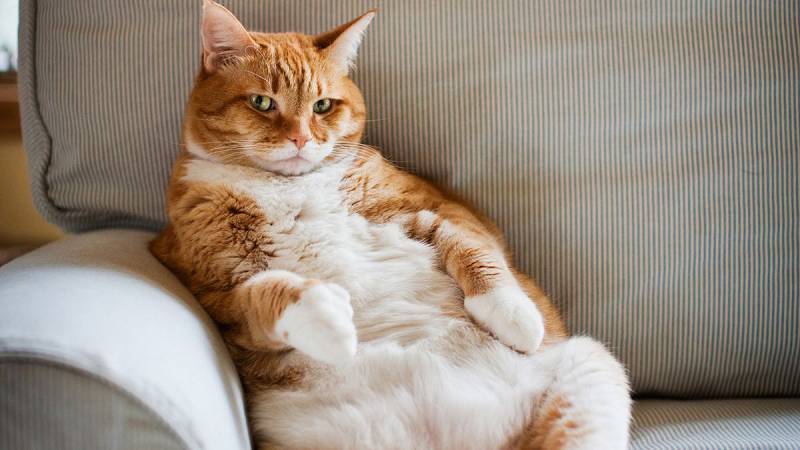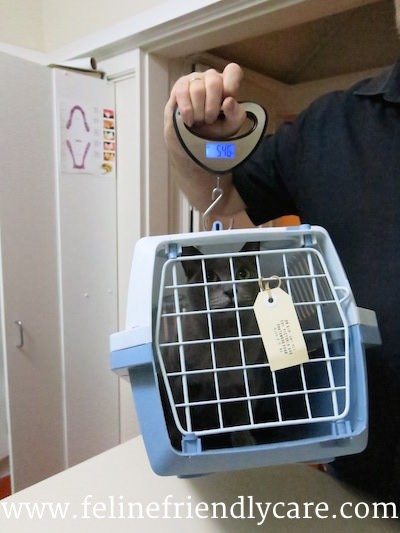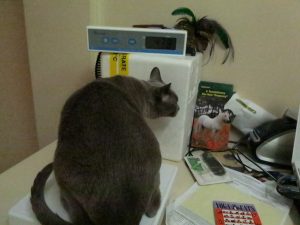
Creating a cat weight chart enables you to track feline weight loss, catching avoidable illnesses in advance.
Why you should know your pet cat’s weight
Discover why your vet must take your cat’s weight
Your pet cat losing weight is not necessarily a big medical issue but can be a sign of an oncoming condition and your vet should be checking it out quickly. To avoid last minute panic (and one of the best ways I know of creating a Feline Friendly awareness of your pet cat’s health) is to take notice of her weight on a regular (eg monthly) basis.
This is because feline weight loss is like a shining beacon that tells you something is wrong. The issue may be behavioral or medical. Either way, something’s not right and it’s Fluffy’s way of telling you that she’s in trouble.
ALL lethal cat medical problems have weight loss as a symptom except maybe cat acromegaly where the bones continue to grow. Cancers and terminal kidney problems cause weight loss which cannot be reversed.
Especially if you don’t see a vet very often, taking note of her weight will be an invaluable guide if something does come up.
Watch the video below to see how easy it is for the vet to do and I have some simple instructions how to weigh your cat at home, just below.
How to create a cat weight chart at home
 Weighing your cat at home is not difficult in this age of digital BAGGAGE scales. Make sure your carrier is not intimidating as, sometimes, your cat has to only get in to be weighed and come straight out again!
Weighing your cat at home is not difficult in this age of digital BAGGAGE scales. Make sure your carrier is not intimidating as, sometimes, your cat has to only get in to be weighed and come straight out again!
You will need:
- Your carrier (with a handle) OR a pillowcase and a strong string to tie the top so it can hang on the scale.
- Your cat. Seriously! – ready, calm, close by.
- The digital BAGGAGE scale that goes to two decimal places – so weight losses of 50 – 100 g can be detected. Typical bathroom scales, even digital, are not accurate enough.
- A paper to keep the record of the weight for future comparison! and a pen. Or else your e-device – whateva!
Getting ready for the weigh in!
- Go slowly – this is new for you both but it is no big deal.As part of any ‘training’ or new activity with your cat, the key is not to let her get away the first time, and not to let them jump out and run away at the end. Keep her in the carrier, once on the ground or solid surface again, for a count of five before opening the door to let them out.
- Contain your cat:
- Attach to Baggage gauge – lift it up gently and read the total weight AND WRITE IT DOWN.
After you have written the weight down
- Set the Carrier and cat down – count to five then let the cat out
- Lift the carrier on the scale again and read the weight of the carrier
- WRITE IT DOWN and do the arithmetic – (Carrier + cat) – carrier = cat weight – Simples!
And write down the weight to tell your vet.
It does not really matter if the weight is different to the vet’s – you are going to keep a log and note the TREND.
- Feline weight gain: ‘oops – too many calories, too palatable, too stressed, too arthritic to exercise’
- or cat losing weight: ‘oops – problemo unless you are specifically restricting your cat’s food intake…
Why Fluffy’s vet needs to check the weight
 When you visit the vet, always make sure you get the weight, and add it to your own chart if you have one.
When you visit the vet, always make sure you get the weight, and add it to your own chart if you have one.
Weight should actually be the number one step in monitoring for a vet. Unfortunately though, many regard it as mundane and boring and too cheap to do, so don’t bother.
However – the cheapest way to find out if a cat has cancer (after checking for diabetes, overactive thyroids and kidney problems) is to feed it more calories (and more easily digestible ones like real chicken meat) for a couple of weeks.
If they don’t gain weight then there is very likely a cancer in there.
